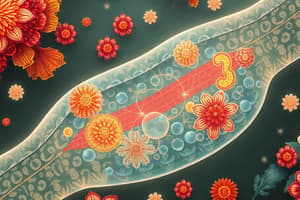Podcast
Questions and Answers
What is diffusion?
What is diffusion?
- The process of molecules moving from an area of high concentration to an area of low concentration. (correct)
- The movement of water across a selectively permeable membrane.
- The facilitated movement of glucose molecules through protein channels.
- The transport of molecules against their concentration gradient using energy.
Which factor does NOT influence the rate of diffusion?
Which factor does NOT influence the rate of diffusion?
- Temperature
- Molecule size
- Presence of water (correct)
- Concentration gradient
How does osmosis relate to osmolality?
How does osmosis relate to osmolality?
- Higher osmolality in a solution leads to more water moving out of cells. (correct)
- Osmosis is solely driven by the presence of permeable solutes.
- Osmosis occurs when solute concentrations are equal.
- Osmosis does not depend on the concentration of solutes in a solution.
What distinguishes primary active transport from secondary active transport?
What distinguishes primary active transport from secondary active transport?
What role does the lipid bilayer play in the cell membrane?
What role does the lipid bilayer play in the cell membrane?
Which type of transport requires energy to move substances against their concentration gradient?
Which type of transport requires energy to move substances against their concentration gradient?
What distinguishes primary active transport from secondary active transport?
What distinguishes primary active transport from secondary active transport?
Which of the following processes is NOT a form of passive transport?
Which of the following processes is NOT a form of passive transport?
Endocytosis is best described as which of the following?
Endocytosis is best described as which of the following?
Which method of transport would most likely be used by cells when absorbing large particles?
Which method of transport would most likely be used by cells when absorbing large particles?
Flashcards are hidden until you start studying
Study Notes
Cell Membranes
- Composed of a lipid bilayer, proteins, and carbohydrates.
- Selectively permeable: Allows some molecules to pass through while blocking others.
Simple Diffusion
- Movement of molecules from an area of high concentration to an area of low concentration.
- Does not require energy.
- Influenced by:
- Concentration gradient: Larger gradient, faster diffusion.
- Temperature: Higher temperature, faster diffusion.
- Molecular size: Smaller molecules, faster diffusion.
- Membrane permeability: More permeable membrane, faster diffusion.
Facilitated Diffusion
- Movement of molecules across a membrane with the help of protein carriers or channels.
- Does not require energy.
- Specific for certain molecules.
Osmosis
- Diffusion of water across a selectively permeable membrane from a region of high water concentration to a region of low water concentration.
- Driven by the difference in water potential between the two regions.
- Influenced by:
- Concentration of solutes: Higher solute concentration, lower water potential.
- Temperature: Higher temperature, faster osmosis.
Osmolality
- Measure of the solute concentration of a solution.
- Determines the movement of water across a membrane.
Active Transport
- Movement of molecules across a membrane against their concentration gradient.
- Requires energy.
- Primary active transport: Directly uses ATP (energy) to transport molecules.
- Secondary active transport: Uses the energy stored in the electrochemical gradient of one molecule to transport another molecule.
- Endocytosis and exocytosis: Forms of active transport where the cell engulfs or releases large molecules using membrane-bound vesicles.
Electrochemical Gradient
- Combination of electrical and chemical gradients for an ion.
- Influences the movement of ions across a membrane.
- Potential difference across a membrane alters the rate of diffusion.
Significance of Transport Mechanisms
- Diffusion: Essential for gas exchange in the lungs, nutrient uptake in the intestines, and waste removal in the kidneys.
- Facilitated diffusion: Facilitates the rapid uptake of glucose into cells, allows for the transport of ions across membranes.
- Active transport: Maintains the concentration gradients of essential ions like sodium and potassium, allowing muscle contraction and nerve impulse transmission.
- Osmosis: Plays a vital role in maintaining cell volume and shape, regulating blood pressure, and filtering waste products in the kidneys.
Studying That Suits You
Use AI to generate personalized quizzes and flashcards to suit your learning preferences.




